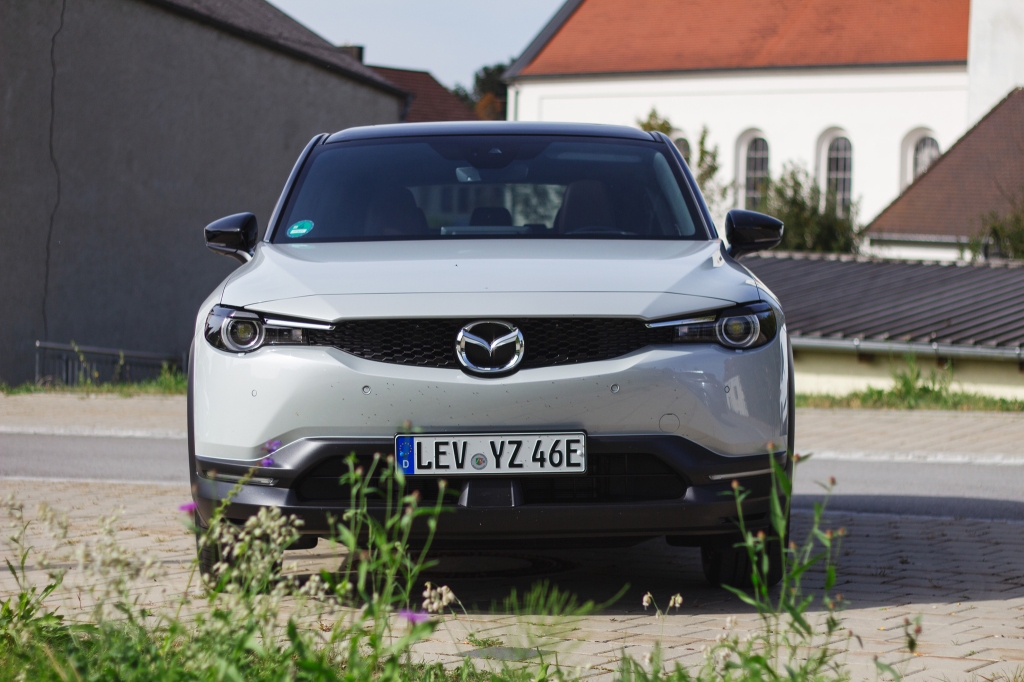Chapter One: A Living Legend
A new Mazda with a rotary. Something Mazda enthusiasts and engineers have been dreaming of for 11 years, after the discontinuation of the RX-8 sports coupe in 2012. The Mazda MX-30 R-EV follows a unique legacy of rotary powered cars made in Hiroshima. Of course we remember legendary cars like the Mazda Cosmo Sport, RX-7 and the Le Mans winning 787b. However, Mazda did not use the rotary engine exclusively for sports cars, but all kind of cars. There was the Mazda Parkway Rotary 26, a rotary powered bus that was built due to its low emission standards. We have seen several coupes, sedans, station wagons and even pick-up trucks which housed the unconventional rotating heart since the late 60s, with some memorable being the 1969 R130, the 1972 RX-3 and the 1990 Eunos Cosmo. Therefore, the Mazda MX-30 R-EV follows a long legacy of rotary powered everyday cars, with many of them being cars most people never heard of. But today we are celebrating the return of the rotary in a very special car with a very unconventional powertrain – even more unconventional than the rotary engine itself.


The rotary engine is not exclusive to sports cars. Utilitarian vehicles like pick-up trucks and busses got the special Mazda treatment as well.
The Mazda MX-30 R-EV is powered by a series-plug-in powertrain. This means, identical to its fully electric sibling, the wheels are always powered by the electric motor alone. The difference is in the source of energy. While the EV houses a 35.5 kWh battery, the R-EV is equipped with a smaller 17.8 kWh unit capable of managing 85km of electric range. Additional to the battery, you will find the place where the magic happens: an 830ccm one-rotor-engine that is connected to a generator, producing 75hp peak power at 4.500 rpm, charging either the battery or being directly used to power the electric motor. Combined with a 50-litre fuel tank, the R-EV promises a range of up to 680km which is 480km more than its EV version, making it capable for long distance travel.
As mentioned before the Mazda MX-30 R-EV follows in the footsteps of Mazda’s rotary powered utilitarian cars. However, the MX-30 is not your average 2020’s SUV. There are some honourable mentions that had a huge impact on the overall design and engine layout. Starting with the most obvious influence, the Mazda RX-8. Mazda introduced the rear suicide doors in 2003 on the 4-seater sports coupe, allowing passengers to comfortably enter the rear of the car while maintaining the sporty roof line. You will find this eye-catching, but sometimes a little bit hard to handle feature on the MX-30 crossover coupe as well.


The MX-30 features suicide doors like the RX-8. The Edition R’s paint is inspired by the Mazda R360. (Pictures by Mazda)
The second car that possibly inspired the idea of the Mazda MX-30 R-EV is the Mazda EX005, a concept car that was presented to the public on the 1970’s Tokyo Motor Show. However, do not mistake it for the quite similar named RX500. While the RX500 is a two-rotor mid-engined sports car concept designed for high-speed testing, the EX005 is a small urban city car. Besides some other quirky features like a diamond shaped wheel layout (two wheels in the middle and respectively one in the front and in the back) allowing it to turn on the spot and being steered by a joystick, it was powered by a 200ccm two-rotor-engine mated to a 3kW generator which produced energy to power an electric motor. In short, the EX005 was a rotary powered series-hybrid just like the Mazda MX-30 R-EV. However, it is missing the plug-in part because it apparently was not a thing in the 70s. As you might have guessed, the EX005 and its technology never made it into production – until now, sort of.


50 years apart: Like the MX-30 R-EV, the EX005 features a rotary powered series-hybrid-system. (EX005 picture by Mazda)
Chapter Two: A Unique Experience
Now that we had a short look into the history of the rotary engine and the spiritual predecessor of the Mazda MX-30 R-EVs powertrain we ask ourselves: What is this car and especially the unique engine layout like to drive? In short, when you have driven the MX-30 EV, you essentially have had the same driving sensation as driving the R-EV. Even though the MX-30 is not the most powerful electric car on the market, it handles extremely well and has a very pleasant and sporty ride. Power delivery is very smooth and Mazda MX-5 aside, regarding driving dynamics the MX-30 is currently my favourite Mazda on the market.
But when the MX-30 R-EV drives like the EV what makes the experience unique? As you would expect, once the battery is flat or you decide to recharge or sustain the battery charge depending on the chosen driving mode, energy is needed. That’s where our magical tool, the rotary engine that is paired to a generator to deliver said energy enters the stage. This is where the experience gets unique. A rotary engine makes an unconventional sound compared to reciprocating engines. Motorsport and Mazda enthusiasts might have the screaming four-rotor 26b of the 787b, loud brap brap noises of a ported two rotor RX-7 or even the smooth turbine-like sound of a stock RX-8 in mind. The R-EVs engine sounds different. Due to the nature of the one-rotor-layout, it does not have the smoothness of the RX-8 and since it will never rev as high as an RX-7 or even the 787b it surely does not scream. Maybe it can be best described as a rumbly noise reminding you of a high-pressure washer. At low speeds the engine noise is quite noticeable, primarily due to its unusual nature, but when reaching speeds over 50 km/h it becomes more subtle.

Rotary inside: The badges differentiate the R-EV from a fully electric MX-30.
When we talk about rotary engines, we have to cover the topic of fuel consumption. RX-7 and RX-8 drivers will know that a consumption of more than 12 litres per 100km is relatively normal. Therefore, many people suspect that the R-EV is not an efficiency miracle. And they are probably right. At highway speeds of approximately 120 km/h, the R-EV will be a little bit thirstier compared to modern reciprocating engines. However, this is where we need to understand the concept of the powertrain. This car wants – and needs to be driven like an EV: drive it, charge it. When you go on a longer journey fuel consumption is higher, but you are not dependent on charging stations and battery capacity.
Chapter Three: An Exciting Future
The Mazda MX-30 R-EV finally revived the rotary engine after 11 years of absence in the form of a very good looking, well-made crossover coupe that fixes the range issues of its pure electric version. It is a perfect car for people who are in for something special while enjoying pure electric driving. Furthermore, the R-EV will fill an important gap in Mazda’s multi-solution-approach to cover diverse mobility solutions for individual customer needs.
From an enthusiast’s point of view, we appreciate the dedication to keep the rotary engine alive – even though it does not power the wheels directly. At the same time, we would have loved to see the return of a Mazda sports car that can continue the legacy of the RX-7. After the reveal of the Mazda RX-Vision in 2015, everyone got high hopes that Mazda had something up their sleeves. And while Nissan revived the Z, Toyota the Supra and Honda the NSX, we still wait for a new Mazda sports car to happen. We all know that a sports car might not sell in high volumes, however we should not underestimate the emotional value and marketing capabilities of such a car. Kids put posters of them on their wall, dreaming of owning one in the future. These kids will be our most loyal fans.


Keeping the spirit of the RX-7 alive: 2015 Mazda RX-Vision and 2023 Mazda Iconic SP. (Pictures by Mazda)
With the recent reveal of the Mazda Iconic SP, we again got a gorgeous concept car with many RX-7 FD and MX-5 design highlights that should be capable of succeeding both cars – as long as it will be available in coupe and roadster form. Like the Mazda MX-30 R-EV, the concept features a series-hybrid-system that houses a two-rotor engine mated to a generator with a 370hp electric motor powering the wheels.
If the Iconic SP makes it into production – and I hope it does – should Mazda decide not to use a rotary-generator unit to produce energy due to cost or complexity reasons – I won’t be mad. Mazda has proven that it can build a very good electric vehicle with the MX-30. And in the end, it does not matter if electricity comes from a rotary-generator, a fuel cell, or a modern battery. The design of the Iconic SP holds the spirit of Mazda’s most iconic sports cars and will make it a deserved halo car either way. And while we wait for the Iconic SP to happen, we can continue to enjoy everything Mazda offers today, from sporty roadsters to rotary powered electric cars.

The MX-30 proves that electric cars are fun to drive, and that Mazda should not hesitate to build an electric sports car, whether it is an EV or R-EV.

